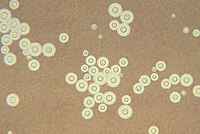
Photo from wikipedia
Nitrogen availability is vital for the growth and survival of Cryptococcus neoformans in the natural environment. Two major ecological reservoirs were previously described for C. neoformans, namely, pigeon guano and… Click to show full abstract
Nitrogen availability is vital for the growth and survival of Cryptococcus neoformans in the natural environment. Two major ecological reservoirs were previously described for C. neoformans, namely, pigeon guano and the woody debris of various tree species. In contrast to the abundance of available nitrogen in guano, C. neoformans must adapt to severely limited nitrogen conditions within arboreal ecological niches. Previously, we demonstrated the role of nitrogen limitation in the production of cryptococcal virulence factors and drug tolerance. The genetic response underlying this adaptation to nitrogen deficiency, however, remains to be determined. Therefore, in the present study we investigated the transcriptomic response of C. neoformans to ecologically relevant nitrogen concentrations using RNA-sequencing. Our data revealed that low nitrogen conditions modulate the expression of numerous virulence genes in C. neoformans. Among these were, CTR4 and CGP1, which showed highly significant modulation under low nitrogen conditions. Furthermore, data analysis revealed the upregulation of antifungal tolerance-related genes in low nitrogen conditions, including genes involved in ergosterol biosynthetic processes and cell wall integrity. Overall, our findings provide insight into the survival of C. neoformans in nitrogen-poor ecological niches and suggest that pre-adaptation to these conditions may influence the pathobiology of this yeast.
Journal Title: FEMS yeast research
Year Published: 2021
Link to full text (if available)
Share on Social Media: Sign Up to like & get
recommendations!